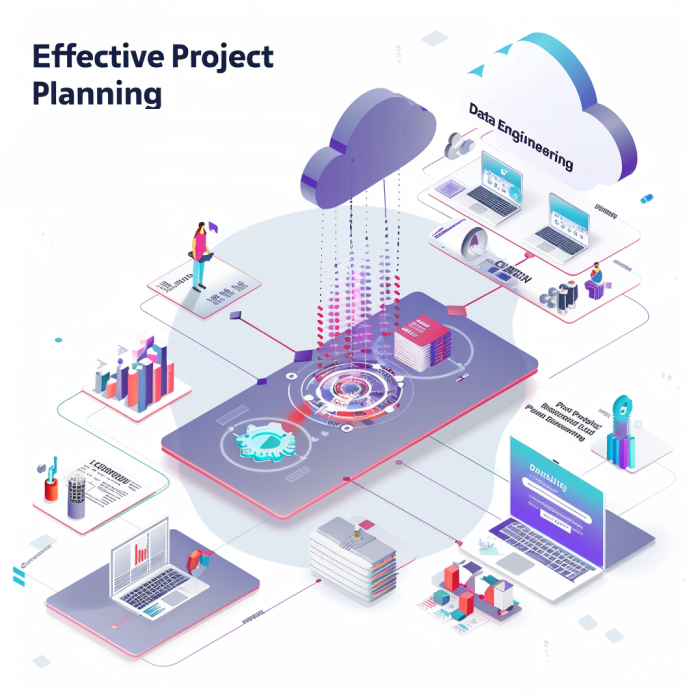Effective Project Planning for Cloud Data Engineering

Introduction to Project Planning in Cloud Data Engineering
Project planning is a critical component of successful data engineering projects, especially when these projects are executed in the cloud. The unique characteristics of cloud computing, such as scalability, on-demand resources, and geographic distribution, offer both opportunities and challenges that must be carefully managed through effective planning.
The process begins with a clear definition of project objectives. These objectives should align with the broader business goals and specify what the project intends to achieve in terms of data processing, storage, and analysis capabilities. It is essential to have a well-defined scope to avoid scope creep, which can lead to delays and budget overruns.
Estimating resources is another crucial step in project planning. This involves determining the types and quantities of resources required, such as computational power, storage space, and human expertise. Cloud environments typically offer a range of services and pricing models, and selecting the right combination can significantly impact the project’s cost-efficiency and performance.
Creating realistic timelines is equally important. This includes developing a detailed schedule that outlines all project phases, from initial data collection and processing to final analysis and reporting. Timelines should be flexible enough to accommodate unexpected challenges yet structured enough to ensure project milestones are met.
Overall, effective project planning in cloud data engineering requires a strategic approach that combines a clear understanding of project goals with a realistic assessment of available resources and potential risks. This foundational step not only sets the stage for successful project execution but also ensures that the project delivers value in alignment with its intended business objectives.
Defining Clear Objectives and Goals
Defining clear objectives and goals is a foundational step in the planning process for any cloud data engineering project. This initial phase is crucial as it sets the direction and scope of the entire project. To start, project leaders should engage with all key stakeholders to gather comprehensive requirements and expectations. This collaborative approach ensures that the project aligns with the strategic goals of the organization and meets the needs of its users.
The objectives of a cloud data engineering project should be specific, measurable, achievable, relevant, and time-bound (SMART). For instance, rather than setting a vague goal like “improve data processing,” a SMART objective would be “reduce data processing time by 30% within six months using cloud-scalable technologies.” This clarity helps in creating a focused project scope and in setting realistic expectations.
Once the goals are defined, it is essential to prioritize them. Not all objectives will have the same level of impact or urgency. Prioritization helps in allocating resources effectively and can guide the project team in maintaining focus on what’s most important. Techniques such as the MoSCoW method (Must have, Should have, Could have, and Won’t have) can be useful in this process. This method allows teams to categorize objectives and focus efforts on those that are critical to the project’s success.
In addition to setting and prioritizing goals, it is also vital to establish clear metrics for success early in the project. These metrics should directly correspond to the project’s objectives and should be agreed upon by all stakeholders. For example, if the goal is to enhance data analysis capabilities, success metrics might include the number of new reports generated monthly or the increase in data retrieval speed.
Lastly, the goals should be reviewed and refined regularly throughout the project lifecycle. This iterative review helps in adapting to any changes in business strategy or external factors that may affect the project. Regular updates to the objectives ensure that the project remains aligned with the organization’s needs and can respond flexibly to new opportunities or challenges.
By meticulously defining and managing the objectives and goals, cloud data engineering projects can be strategically positioned to deliver significant value, ensuring that they meet the desired outcomes and contribute effectively to the organization’s data capabilities.
Estimating Resources and Budgeting
Estimating resources and budgeting are critical components of project planning in cloud data engineering. This process involves a detailed analysis of the resources required to meet project goals and the associated costs. Effective resource estimation not only ensures that the project remains financially viable but also helps in avoiding delays and resource shortages.
To begin with, it’s essential to define the scope of the project clearly. This includes understanding the data volumes, the complexity of data transformations, and the expected data throughput. These factors significantly influence the type and amount of cloud resources needed, such as compute instances, storage capacity, and data transfer limits.
Once the scope is defined, the next step is to map out the specific cloud resources required for each phase of the project. For instance, initial stages might require heavy computational resources for data processing, while later stages might need more storage or specific services related to data analytics. It’s crucial to choose the right mix of services offered by cloud providers like AWS, Azure, or Google Cloud Platform, which can also impact the cost.
Cost estimation is another pivotal aspect. Cloud services typically charge based on usage, which includes factors like compute hours, storage space, data egress, and additional services like machine learning or data streaming. To estimate costs accurately, project planners should use the pricing calculators provided by cloud services, which help in forecasting monthly expenses based on the expected usage.
Moreover, it’s advisable to consider the use of reserved instances or savings plans if the project has predictable resource usage, as these options can offer significant cost savings over on-demand pricing. Additionally, keeping an eye on the evolving prices and services of cloud providers can help in optimizing the budget over time.
Another important factor is the contingency budget. Given the dynamic nature of data engineering projects, unexpected costs can arise, such as increased data volumes or additional processing power needed for data cleansing. A contingency budget helps in managing these unforeseen expenses without compromising the project timeline or quality.
In summary, effective resource estimation and budgeting for cloud data engineering projects require a thorough understanding of project requirements and careful planning. By leveraging cloud pricing tools and staying adaptable to project demands, organizations can ensure that their data engineering projects are both efficient and cost-effective.
Creating Realistic Timelines and Milestones
Creating realistic timelines and milestones is a critical aspect of project planning in cloud data engineering. This process involves several key steps that ensure the project remains on track and meets its objectives efficiently.
Firstly, it is essential to define the scope and goals of the project clearly. This clarity helps in identifying the major milestones that are critical for the project’s success. Milestones should be specific, measurable, achievable, relevant, and time-bound (SMART). They serve as checkpoints that help the team stay on track and also provide a mechanism for evaluating the progress of the project.
Once the milestones are defined, the next step is to estimate the time required to achieve each milestone. This involves a detailed analysis of the tasks involved and the resources available. It is important to be realistic in these estimations to avoid setting up the project for delays. Consider the best-case, average-case, and worst-case scenarios for each task and use this information to create a balanced timeline.
Incorporating buffer times into the timeline is also crucial. These buffers account for potential delays and unforeseen challenges that might arise during the project. They help ensure that the project timeline is flexible enough to accommodate changes without causing significant disruptions.
Another important aspect is the continuous monitoring and adjustment of the timeline. As the project progresses, some tasks may take more or less time than initially estimated. Regularly reviewing the timeline and adjusting it based on actual progress is essential for keeping the project on track. This iterative process allows the project team to respond to changes in a controlled and effective manner.
Effective communication throughout the project is vital. All stakeholders should be kept informed about the progress, changes, and any adjustments to the timelines and milestones. This transparency helps in managing expectations and ensures that everyone involved is aligned with the project’s goals and timelines.
Lastly, using project management tools can greatly enhance the efficiency of creating and tracking timelines. These tools offer features like Gantt charts, which provide a visual representation of the project timeline and help in easy tracking of progress against the defined milestones.
By following these steps, project managers can create realistic timelines and milestones that not only guide the project team effectively but also provide stakeholders with confidence in the project’s management and its successful completion.
Risk Management and Contingency Planning
Risk management and contingency planning are critical components of project planning in cloud data engineering. These practices ensure that projects are resilient and adaptable to unexpected challenges, thereby safeguarding the integrity and continuity of data operations.
Identifying Potential Risks
The first step in effective risk management is the identification of potential risks that could impact the project. In cloud data engineering, these risks can range from data breaches and loss of data integrity to service downtimes and compliance violations. It is essential to conduct a thorough risk assessment by analyzing the project scope, technology stack, data sources, and integration points. Engaging stakeholders from different departments, such as IT security, compliance, and operations, can provide a comprehensive view of potential vulnerabilities.
Risk Assessment and Prioritization
Once risks are identified, the next step is to assess their likelihood and potential impact on the project. This assessment helps in prioritizing risks based on their severity and the probability of occurrence. Tools like risk matrices can be utilized to categorize and prioritize risks, providing a clear framework for addressing the most critical vulnerabilities first.
Developing Contingency Plans
For each high-priority risk, a contingency plan should be developed. These plans outline the steps to be taken when a risk materializes, aiming to minimize disruption and quickly restore normal operations. Contingency plans should include clear roles and responsibilities, step-by-step recovery procedures, and communication protocols to ensure all team members are informed and prepared to act swiftly.
Implementing Risk Mitigation Measures
To prevent risks from occurring, proactive risk mitigation measures should be implemented. In the context of cloud data engineering, this could involve using encrypted data transfers, implementing robust access controls, regularly updating software to patch security vulnerabilities, and conducting frequent backups to prevent data loss. Additionally, choosing reliable cloud service providers and ensuring they comply with industry standards is crucial for reducing risks related to data availability and security.
Regular Monitoring and Review
Risk management is an ongoing process that requires regular monitoring and review to be effective. The project team should continuously track the status of identified risks and the effectiveness of mitigation measures. This ongoing review allows for adjustments in risk management strategies as the project evolves and as new risks emerge. Tools such as dashboards and real-time alerts can be instrumental in monitoring risk indicators.
Training and Awareness
Finally, training and awareness are key to ensuring that all team members understand the risks associated with the project and are prepared to implement the contingency plans if necessary. Regular training sessions and updates on new security protocols or potential threats can help maintain a high level of preparedness and reinforce the importance of risk management practices.
By integrating these risk management and contingency planning steps into the project planning process, cloud data engineering projects can be better equipped to handle uncertainties and ensure the smooth and secure handling of data across cloud platforms.
Monitoring Progress and Adjusting Plans
Monitoring progress and adjusting plans are critical components of managing cloud data engineering projects. These processes ensure that the project remains on track and can adapt to changes or unforeseen challenges effectively.
- Establishing Key Performance Indicators (KPIs): The first step in monitoring progress is to define clear, measurable KPIs that align with the project’s objectives. These indicators might include metrics related to data processing speeds, accuracy of data transformations, and adherence to project timelines. By setting these benchmarks, teams can quantitatively assess their progress and identify areas needing attention.
- Regular Progress Reviews: Scheduling regular meetings to review the progress of the project is essential. These reviews should involve all key stakeholders and project team members. During these sessions, participants can discuss the status of the project, review KPIs, and share any issues or roadblocks. This regular communication helps to ensure that everyone remains aligned with the project goals and timelines.
- Utilizing Project Management Tools: Leveraging project management software is highly beneficial in tracking tasks, dependencies, and timelines. Tools like JIRA, Asana, or Microsoft Project can provide visual representations of the project’s progress and help in identifying any delays or bottlenecks. Additionally, these tools can facilitate better resource management and allocation throughout the project lifecycle.
- Adaptive Planning: Flexibility in project planning is crucial. As projects progress, new insights, changing business needs, or technical challenges might necessitate plan adjustments. Adaptive planning involves revising strategies and timelines based on current project realities. This approach allows teams to manage risks more effectively and leverage new opportunities as they arise.
- Feedback Mechanisms: Implementing a structured feedback mechanism within the team and with stakeholders can provide critical insights into the effectiveness of the project execution. Feedback can help in refining processes, addressing quality issues, and improving team collaboration and performance.
- Risk Management: Continuous risk assessment should be part of the project management process. Identifying potential risks early and developing mitigation strategies can prevent significant disruptions. This proactive approach involves regular risk reviews and updates to the risk management plan.
- Celebrating Milestones: Recognizing and celebrating key milestones not only boosts team morale but also provides an opportunity to reflect on what has been achieved and what needs to be improved. These celebrations can be simple acknowledgments in team meetings or more formal recap sessions that include learnings and successes.
- Documentation and Reporting: Maintaining detailed documentation and regular reporting is vital for transparency and for informing decision-making processes. Reports should highlight achievements, challenges, and deviations from the plan. They serve as a formal record of the project’s progress and are essential for communicating with external stakeholders.
By effectively monitoring progress and being willing to adjust plans as necessary, teams can enhance their ability to deliver successful cloud data engineering projects. This dynamic approach to project management not only addresses immediate issues but also helps in building a responsive and agile project environment.
Key Takeaways for Successful Cloud Data Engineering Projects
Effective project planning is crucial for the success of cloud data engineering projects. By defining clear objectives, accurately estimating resources, and setting realistic timelines, teams can ensure that projects are completed efficiently and effectively. It is essential to maintain flexibility and adaptability throughout the project to accommodate any unforeseen changes or challenges. Regular communication and collaboration among team members and stakeholders also play a vital role in keeping the project on track and aligned with business goals. Ultimately, thorough planning and execution can lead to the successful delivery of cloud data engineering projects, providing valuable insights and supporting informed decision-making across the organization.







